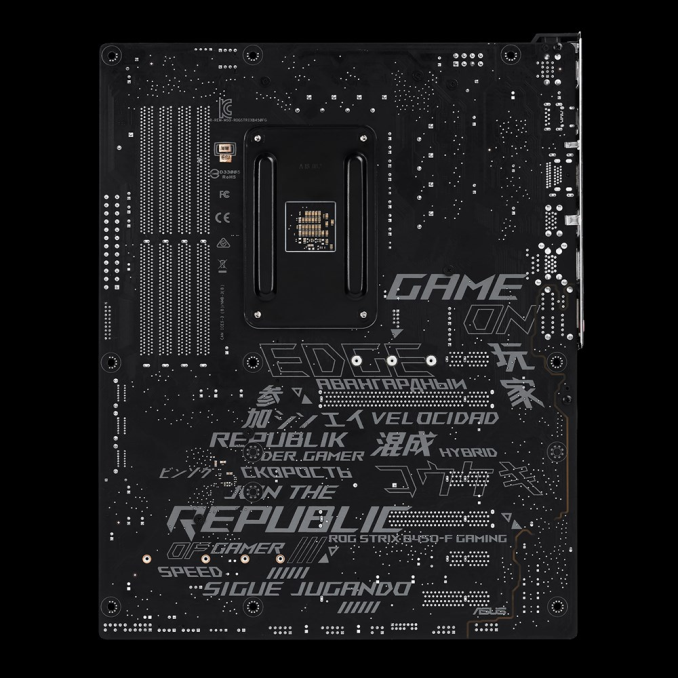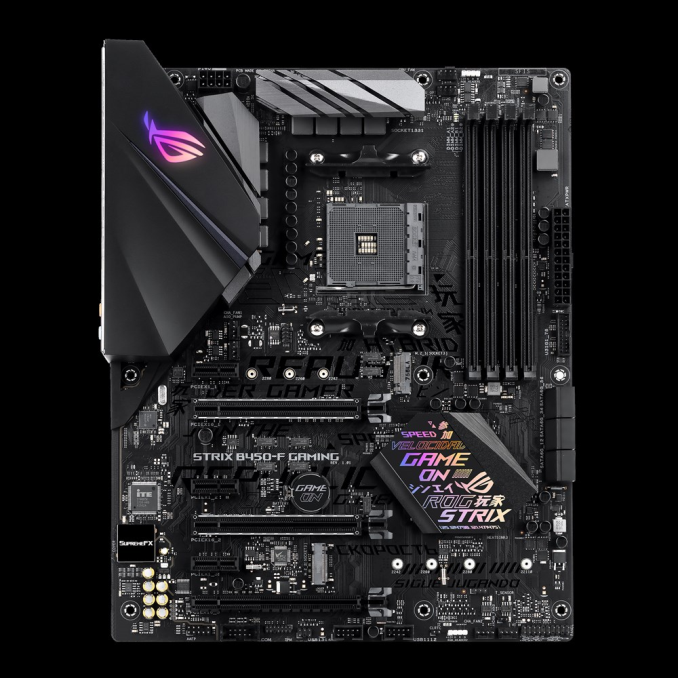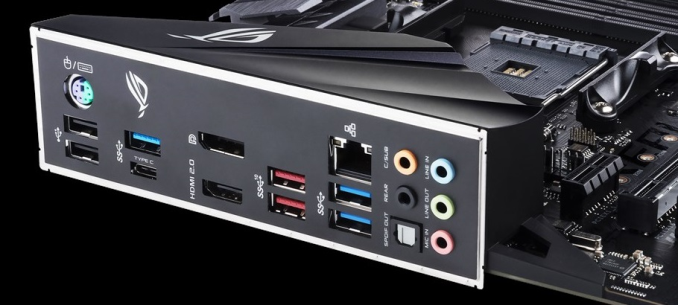Analyzing B450 for AMD Ryzen: A Quick Look at 25+ Motherboards
by Gavin Bonshor on July 31, 2018 8:00 AM ESTASUS ROG Strix B450-F Gaming
Opening up on the ASUS line-up of B450 motherboards, the ROG Strix B450-F Gaming looks to be one of the most premium rich of all the B450 options at launch. The Strix B450-F is a mid-ranged ATX offering with a host of features including a SupremeFX S1220A audio codec, an Intel I211-AT Gigabit networking controller and an HDMI 2.0b output on the rear panel; this is in addition to a Strix DisplayPort 1.2 output to make use of the Ryzen 2000 series APUs featuring Vega graphics. The Strix B450-F has an integrated RGB LED behind the ROG eye on the rear panel cover, with the capability to expand upon this thanks to two included AURA Sync capable RGB headers.
The general theme of the design comes in a different style to ROG themed boards of the past which were generally red and black, with the B450-F Gaming following its own journey with a black and grey contrasting PCB. The biggest focal point of the design is an extravagant looking chipset heatsink which has a futuristic styled ROG Strix sticker. An alternatively designed sticker with the same futuristic text, but with a subtler design will be available in the box.
Following in line with the majority of B450 motherboards, the Strix B450-F Gaming has support for DDR4-3200 memory, with a maximum capacity of 64 GB across the four available RAM slots. A total of six 4-pin headers make up the cooling options which are divided into two CPU fan headers, three regular chassis headers and one dedicated for an AIO or water cooling pump. A further USB 3.1 5 Gbps and four USB 2.0 ports can be opened up by the use of onboard headers and a clear CMOS jumper is also featured on this board instead of a dedicated button.

The ROG Strix B450-F Gaming's uniquely styled PCB on the rear
The ROG Strix B450-F Gaming has two full-length PCIe 3.0 x16 slots which when both slots are populated, operate at x8/x4. With the bottom full-length PCIe 2.0 x4 slot being driven directly from the B450 chipset, it’s possible to run AMD 3-way CrossFire multi-graphics configurations on this particular model. Both the PCIe 3.0 x16 slots feature a wave of ASUS’s SafeSlot metal coating designed to provide the slots with extra protection. The B450-F Gaming also features three PCIe 2.0 x1 slots.
Focusing on power options, the ROG Strix B450-F Gaming looks to feature 8-phase digital power delivery most likely consisting of a 6+2 design. An 8-pin ATX 12 V power input is present to deliver power directly to the CPU, whereas a single 24-pin ATX power input is also present to provide auxiliary power to the board and the rest of the controllers. A metallic silver heatsink covers the MOSFETs and looks rather formidable for a mid-ranged motherboard.
The majority of the storage connectivity on the Strix B450-F Gaming comes through six right-angled SATA 6 Gbps ports with four being driven directly from the B450 chipset. The SATA 6 Gbps ports support different RAID arrays including 0, 1 and 10. Also present is a duo of M.2 slots with both having support for PCIe 3.0 x4 M.2 drives, while the top slot which supports both PCIe and SATA drives up to a size of M.2 2280 (22 x 80 mm), the bottom slot only supports PCIe 3.0 x4 drives with a sizing up to M.2 22110 (22 x 110 mm).
On the rear panel, there are USB connections aplenty with two USB 3.1 10 Gbps ports (in blue), four USB 3.1 5 Gbps Type-A ports (in blue) and two USB 2.0 ports. Also present on the rear panel is five 3.5mm audio jacks an optical S/PDIF output which is powered by the ASUS ROG branded Supreme FX S1220A codec; this is further enhanced through the ASUS Sonic Studio III software. A single LAN port is featured controlled by an Intel I211-AT Gigabit network controller, with a PS/2 combo port and a pairing of video outputs consisting of a DisplayPort and HDMI 2.0 output finishing off the rear. One of the biggest aesthetic changes to the rear panel comes through a black I/O shield which is pre-mounted to the board out of the box.
The ASUS ROG Strix B450-F Gaming as the naming scheme would state, is specifically aimed at gamers looking to make use of premium integrated features such as the SupremeFX S1220A audio codec, but without spending $200+ on a more feature-packed X470 motherboard. The major disadvantage with B450 is the lack of NVIDIA SLI multi-graphics support, but the Strix B450-F is as good looking as they come on paper without spending excessively for unnecessary features. The rear of the PCB is a particular visually pleasing point, although most users won't see this aside from installing the board into their chassis of choice. The ROG Strix B450-F Gaming is set to retail for $129.99 which makes this one of the most expensive, but also feature packed B450 boards at launch.




_thumb.jpg)
_thumb.png)
_thumb.jpg)
_thumb.png)
_thumb.jpg)
_thumb.png)








62 Comments
View All Comments
bi0logic - Tuesday, July 31, 2018 - link
It looks like the price link to the "TUF B450-Plus Gaming" is going to an amazon search for "ASRock B450M Pro4"eastcoast_pete - Tuesday, July 31, 2018 - link
Thanks Gavin, I know this is a lot of information to go through and present. I would love to see a follow-up on these questions:1. Especially for these compact boards, any problems with stock processor heat sinks blocking DIMM slots, i.e. do DIMMs with heat spreaders still fit with a Wraith or Spire cooler, respectively?
2. I have my eye on the Aorus Pro WiFi or something similar, but am wary of the placement of the WiFi antenna connectors right next to two of the USB 3 connectors. I frequently use 3-4 USB 3 devices at the same time frequently, and am wary of the USB 3 - WiFi interference with that placement. Any chance Gigabyte could state if/that they got that taken care of?
Thanks!
Also, still looking forward to your Ryzen 2200/2400 GPU overclock chapter on that duo. Any chance we'll see it soon?
sonofgodfrey - Tuesday, July 31, 2018 - link
Second to last table is labeled X470 Motherboards.PingSpike - Tuesday, July 31, 2018 - link
It looks like the ASUS ROG STRIX B450-F GAMING inherits some of the layout features of the (much more expensive) x470 Crosshair 7 in that it steals some of the CPU lanes to get a second full PCI-e 3.0 M.2 slot. Then 8x goes to PCI-e 16 1, the remaining 4x to PCI-e 16 2 and finally a chipset PCI-e 2.0On the surface, this seems like it has totally ignored the bifrucation limitations that supposedly are inherent to the B450 chipset.
In other words, I thought you couldn't get that on this chipset.
Dragonstongue - Tuesday, July 31, 2018 - link
well at least the pricing is "more inline" with the pricing they should be, newer boards, better componentes that actually save the maker a bit of coin per board made, so they keep the same "launch price" is acceptable in my books coming from gen 1 (I so hate the naming AMD used for Ryzen 1xxx and 2xxx needless confusion for nothing)x3xx to x4xx same concept, reduced price to produce so they save some money, but the vast majority of vendors used these "savings" to cram more disco light show RGB on the boards to jack the price up some instead.
seems at least with the B4xx boards the vendors took a "better" approach beyond a few more "premium" boards which rightfully have an increased price (justifiable, maybe, but I myself have zero need of RGB and would only buy a more expensive board that offered them at the increased price if they were WORTH it as far as just overall better then lower cost boards, sadly, there seems to be little difference in more "premium" beyond a butt load of extra RGB little better in VRM etc which are much more useful and required IMO)
they could almost have a market for the premium boards RGB free, so pay a bit less for people like me who do not want all the RGB crud but still get the increased premium sound/VRM/BIOS etc ^.^
WasHopingForAnHonestReview - Wednesday, August 1, 2018 - link
Nice review. Good work.Im amazed that almost every comment is a nitpick. Rough life, Ian.
Flappergast - Wednesday, August 1, 2018 - link
Nice overview on the last page. I’m looking for mITX WiFi - nice to see some good boardsSakkura - Wednesday, August 1, 2018 - link
As documented by Buildzoid, the Asrock B450 Pro4 does not have the claimed 6+3-phase VRM. It is a pure 3+3-phase. Same probably applies for the B450M Pro4.https://youtu.be/yWAwOH-egFs?t=2104
JohanPirlouit - Wednesday, August 1, 2018 - link
Hi everyone,Am I the only one to see that on the AMD picture:
- CPU: 2x SATA 3Gbps
- Chipset: 6x SATA 3Gbps
What do AMD talks about: SATA "3" (known as "6Gbps") or SATA 3Gbps (aka SATA II)?
Sakkura - Wednesday, August 1, 2018 - link
They mean SATA3 = SATA 6Gbps. Annoying that we keep running into these easily confused naming schemes (see also: USB 3.1 Gen1 and Gen2). At least SATA is getting old enough that we should soon be able to just drop the version number (unlike USB 2.0 there's really no reason to make modern hardware with SATA2).